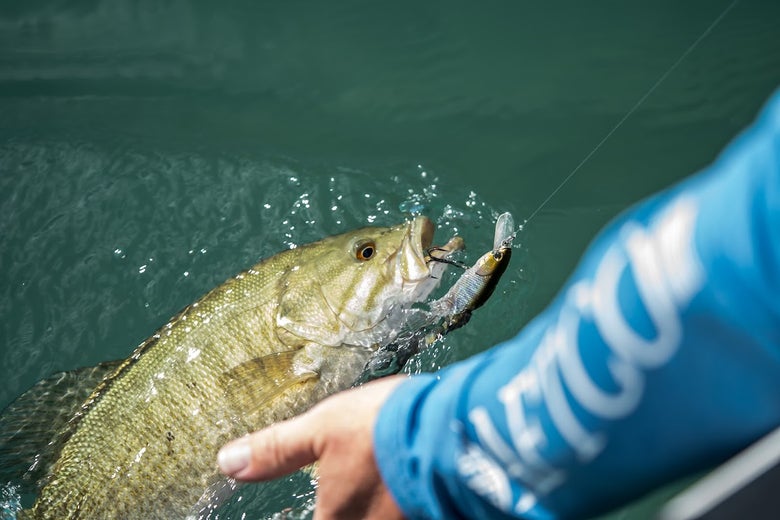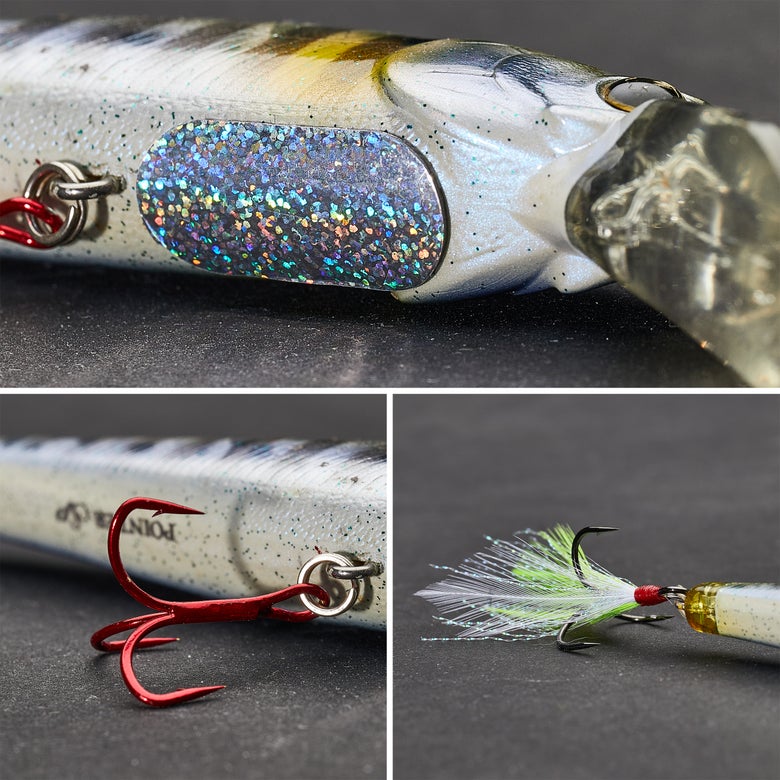Jerkbaits Gear Guide

Originally believed to only be a cold-water tactic that excelled during the pre-spawn, the jerkbait has evolved into a year-round producer, allowing anglers to target fish throughout the seasons thanks to different sink rates, sizes, and diving depths. With such a wide variety of lethal options to choose from, it’s a mistake to hit the lake without one tied on. The quick, erratic movement of the jerkbait is what sets it apart from other reaction baits, making it one of the best lures for triggering bites from fish even when they aren’t actively feeding.
The sharp, unpredictable action of a jerkbait entices lethargic fish to react in the winter, and when baitfish become the primary food source during the post-spawn, the minnow profile perfectly mimics the desired forage. As bass begin to group up during the spring, the jerkbait has the power to fire up an entire school, which is one of the few times the biggest fish in your lake will let their guard down. Having the proper gear is crucial to your success, so in this guide, we will go over in-depth gear recommendations, treble hook modifications, and the basics of a proper retrieve.
Jerkbait Rods
To effectively cast and impart action with your favorite jerkbait, a slightly shorter casting rod ranging from 6’6” to 7’2” in length is ideal for twitching and jerking the rod tip down toward the water. A medium-powered, moderate-fast tapered blank is critical for producing the correct action while also providing enough give to keep the treble hooks pinned without ripping them out or pulling the lure away from a fish. Many anglers also prefer a shorter handle to avoid catching a sleeve when twitching the rod. If conditions are really tough and you are forced to downsize to a finesse jerkbait, it may be time to pull your favorite medium-action spinning rod of a similar length from the rod locker.
Jerkbait Reels
Jerkbaits are often most effective in windy conditions, and when paired with light line, they can be exceptionally difficult to cast. Using a compact 70–100 casting reel can help combat these challenges, as the shallow spool rotates with less inertia, which translates into longer casts and fewer backlashes. Ideally, a reel with a gear ratio from 6:1 to 7:1 is the sweet spot. If you use a reel that's too fast, you run the risk of overpowering the action of your ripbait by pulling in too much line. Once again, if the situation calls for working a finesse jerkbait, a 3000-size spinning reel is the right tool for efficiently picking up line and having plenty of line capacity.
Jerkbait Line
In most cases, fluorocarbon in the 10-lb to 12-lb range is the best choice for jerkbaits. Nearly invisible underwater, fluorocarbon is crucial when your cadence involves long pauses and fish get plenty of time to stare down your jerkbait. If the fishing is really challenging and the water is crystal clear, or if you need a little extra depth out of your jerkbait, dropping down to 8-lb test can make a big difference. Alternatively, when the water is dirty and the fish are higher up in the water column, a heavier line will keep your jerkbait closer to the surface and provide some added insurance around large fish.
Modifications & Rigging
Always inspect your treble hooks and upgrade them if necessary. There are many suitable options out there, but whatever you choose, make sure they are as sharp as possible to help increase your hookup ratio. Try adding a red treble hook up front to create a visible strike point or consider using a feathered treble hook at the rear hook for some added attraction. Feathered treble hooks also create drag in the water and help your jerkbait stop quickly on the pause. As a note of caution, when replacing trebles, make sure to use a similar size to the stock hooks, as it is easy to change the action and suspension of your jerkbait if your hooks are too heavy. Lure or hook covers are also a great call, as they will help prevent snags and tangles while your rods are not being used.

Retrieve Technique
The most common mistake anglers make is to immediately begin jerking the rod tip as soon as the lure hits the water. Unless the fish are feeding right on the bank or close to the surface, it will be more advantageous to reel your jerkbait down with a few turns of the reel handle and get the lure beneath the surface. To start, make a long cast and keep your rod tip pointed toward the lure. After you’ve given the reel a couple of turns, twitch your rod tip in a downward motion toward the water and let the rod tip recoil back in the direction of the jerkbait. You then want to let the lure sit motionless (also known as the “pause”) before reeling in some slack and beginning the twitching action again. It is very important to always impart action with slack in your line to maximize the action of your jerkbait. Even a little bit of tension in your line can cause the bait to drift forward and cause fish to shy away, so make sure to maintain that slack between twitches, and always use the rod to move the jerkbait instead of the reel.
Another important thing to note is to always experiment with your twitch cadence and the length of your pause. The most effective retrieve will vary based on the season, water temperature, and attitude of the fish, so be sure to mix up your retrieve until you figure out what the bass want on a given day. During the winter or colder months, it becomes increasingly important to slow things down with a longer pause to get lethargic fish to react, and sometimes you may have to count several seconds between each snap of the rod tip during the winter. When water temperatures begin to rise, a faster and more aggressive cadence may be more effective.
Colors
Jerkbait fishing is a relatively clear-water technique, as it often relies on the fish being able to see and zero in on its erratic darting and side-to-side action. As a rule of thumb, the clearer the water, the more translucent you will want to go with your color selection. Conversely, when fishing dirtier or more stained water, brighter and more opaque colors tend to be more effective. Chrome can be a killer option under bright and sunny skies, while chartreuse shad or anything with a white base will perform in stained water or low-light conditions. If you are targeting smallmouth specifically, try tempting them with bright chartreuse or red-colored baits to really fire them up. As with all techniques, the weather conditions and water clarity will always play the biggest role in color selection.
Jerkbaits differentiate themselves from other reaction baits, as they allow anglers to work them with a slower cadence instead of simply reeling them to create the desired action. With such a wide variety of retrieve techniques, diving depths, and targeted colorways, the jerkbait is a versatile hard bait that can find success throughout the year.

















































